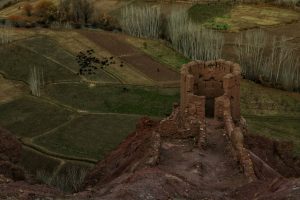Shahr-e sorkh and Zuhak Castle of Bamiyan (Part 1)
Assadullah AMIRI | Mohammad HOSSAINI (Translator)
Shahr-e Zuhak or Shahr-e sorkh are among ancient monuments in Bamiyan, which are also known as Zuhak City, Zuhak Castle, Shahr-e sorkh (literally means red city) and Sorkh dar (literally means red door) Zuhak City locates 17 KMs far from east of Bamiyan city along with Salsal and Shahmamah statues of Buddha, and at the juncture of Kalu, Bamiyan and Shibar. Shahr-e Zuhak is located on the summit of red mountains with height of about 150 meters in Do-abi area of Shash-pol that is the junction of Kaloo and Bamiyan rivers.

Fig 1. The exterior of Zuhak City. Mohammad Ali Shaida.
About ten kilometers in west of Zuhak City, Ahangaran valley is situated that is attributed to Kavah Ahangar. In terms of military and transportation, Zuhak City holds a strategic position as an ancient fortress on top of Mount Qarakh on the verge of historic road of Bamiyan, known as the Silk Road. Zuhak City is surrounded by mountains and has a beautiful panorama of the green and watery valleys of Bamiyan, Kalu and Shash-pol (literally means six bridges).
The ancient area also known as the Shahr-e sorkh and Zuhak Castle has two main parts which are the city and the castle. The Shahr-e sorkh section is located on a flatter space at the edge of the mountain, while Zuhak Castle is a little higher towards the top of the mountain on the verge of Shahr-e sorkh.
Zuhak Castle and City is a mythical and historical land associating with the myth of Zuhak reign (in some texts Azhi Dahak) also known as Zuhak Mardush along with the legendary battles of Feraydoun and Kavah Ahangar with him.

Fig 2. One of the protective towers in Zahak Castle. Mohammad Ali Shaida.
The magnitude of the historic city of Zuhak is not clearly known. However, some historians have written that there were about 12,000 houses and one thousand shops in the Shahr-e sorkh. They have even mentioned a city underneath that city. Nevertheless, the area of the Shahr-e sorkh is estimated to be about one kilometer by one and a half kilometers after taking remained structures into consideration. Some writers have considered Zuhak Cave on the outskirts of the city and mythical Nariman city connected to the city of Zuhak, on the side of Kaloo Valley and southeast of the city.
The mythical and historical city and castle of Zuhak is inaccessible from three directions: west, north and the south. It was only accessible through one road in the east. Due to the steep slope toward the valley skirt, natural access to the city of Zuhak from the east was also impossible. Hence, constructors of Zuhak City had also constructed a twisting road with protective towers. After centuries, the same ancient route is still the only way to the top of the mountain and access to the city of Zuhak. At the last point of this access route to the city of Zuhak, near the top of the mountain at the edge of the precipice, a tunnel has been excavated at the edge of the mountain, which is considered as the entrance gate of the city. This tunnel is like a cylinder with a radius of about three meters at the entrance and a length of about 5 meters. It is the only entrance to the Shahr-e sorkh and the mythical city of Zuhak.
The aforementioned tunnel is a bottleneck that in case of closing, it blocks any access to the city and makes it impossible to reach. Any kind of transportation, access or entrance to the city merely depends on the opening and closing of the same tunnel-gate.


